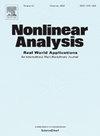IF 1.8
3区 数学
Q1 MATHEMATICS, APPLIED
引用次数: 0
摘要
生态系统受到自然和人为干扰的严重影响。本研究利用一个四物种生态系统模型来研究各物种种群密度的渐近行为,特别是解的均匀有界性和所有解向内点的收敛性。考虑到干扰的影响,采用了一个具有时变系数的微分方程系统来描述数学模型。如果干扰的程度和持续时间很大,生态系统就可能遭到破坏,导致物种灭绝。因此,本研究假设干扰的影响会逐渐减弱,这取决于物种的适应能力和环境复原力。这一假设采用绝对可积分时变系数建模。如果所有解都收敛到一个内部点,则生态系统中的所有物种都能共存。因此,这项研究为模型的持久性提供了充分条件。此外,在时变系数不是绝对可积分的情况下,利用三物种生态系统模型分析了物种灭绝和生存的可能性。本文章由计算机程序翻译,如有差异,请以英文原文为准。
Convergence of solutions for a four-species food chain model with decaying disturbances
Ecosystems are significantly impacted by both natural and anthropogenic disturbances. This study utilizes a four-species ecosystem model to examine the asymptotic behavior of the population densities of each species, particularly the uniform boundedness of the solutions and the convergence of all solutions to an interior point. Considering the effects of disturbances, a system of differential equations with time-varying coefficients is employed to describe the mathematical model. If the magnitude and persistence of disturbances are substantial, the ecosystem may be destroyed, leading to species extinction. Thus, this study assumes that the effects of disturbances gradually diminish, depending on species adaptability and environmental resilience. This assumption is modeled using absolutely integrable time-varying coefficients. If all solutions converge to an interior point, all species coexistence within the ecosystem is achieved. Consequently, this study provides sufficient conditions for the permanence of the model. Moreover, in the scenario where the time-varying coefficients are not absolutely integrable, the potential for species extinction and survival is analyzed using a three-species ecosystem model.
求助全文
通过发布文献求助,成功后即可免费获取论文全文。
去求助
来源期刊
CiteScore
3.80
自引率
5.00%
发文量
176
审稿时长
59 days
期刊介绍:
Nonlinear Analysis: Real World Applications welcomes all research articles of the highest quality with special emphasis on applying techniques of nonlinear analysis to model and to treat nonlinear phenomena with which nature confronts us. Coverage of applications includes any branch of science and technology such as solid and fluid mechanics, material science, mathematical biology and chemistry, control theory, and inverse problems.
The aim of Nonlinear Analysis: Real World Applications is to publish articles which are predominantly devoted to employing methods and techniques from analysis, including partial differential equations, functional analysis, dynamical systems and evolution equations, calculus of variations, and bifurcations theory.

 求助内容:
求助内容: 应助结果提醒方式:
应助结果提醒方式:


